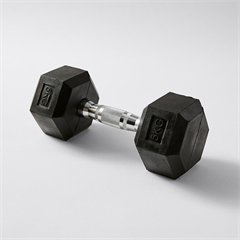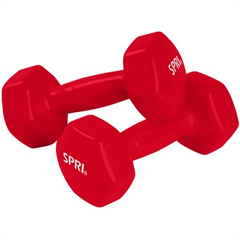Injury prevention should be a top priority when incorporating dumbbell workouts into your fitness routine. Here are some essential tips to help you minimize the risk of injuries while using dumbbells:
- Warm-Up Thoroughly: Begin your workout with a proper warm-up to increase blood flow, prepare your muscles, and reduce the risk of strains or tears. Include light cardio exercises and dynamic stretches to loosen up your joints and muscles.
- Start with the Right Weight: Choose dumbbells that are appropriate for your current fitness level. Starting with weights that are too heavy can lead to poor form and potential injuries. Gradually increase the weight as you become stronger.
- Maintain Proper Form: Correct form is crucial for injury prevention. Pay attention to your posture and technique during every exercise. If you’re unsure about your form, consider working with a certified trainer or using mirrors to check your alignment.
- Use a Controlled Range of Motion: Avoid overextending your joints or using excessive momentum to lift the weights. Focus on controlled movements throughout each exercise, both during the concentric (lifting) and eccentric (lowering) phases.
- Progress Gradually: Don’t rush into heavy lifting or advanced exercises. Progress at a pace that allows your muscles and joints to adapt safely. Incrementally increase the intensity, weight, or repetitions over time.
- Incorporate Rest Days: Ensure that you have adequate rest days between intense workouts. This allows your muscles time to recover and reduces the risk of overuse injuries. Consider a split routine to target different muscle groups on different days.
- Balance Your Routine: Include exercises that target all major muscle groups to maintain balance and reduce the risk of muscle imbalances that can lead to injury. A balanced workout also includes flexibility and mobility exercises.
- Listen to Your Body: Pay attention to any pain or discomfort during your workout. If you experience sharp or persistent pain, stop the exercise immediately. Pushing through pain can lead to injury.
- Stay Hydrated and Nourished: Proper hydration and nutrition are essential for maintaining energy levels and muscle function during your workouts. Dehydration can lead to muscle cramps and fatigue, increasing the risk of injury.
- Use Proper Footwear: Wear supportive and comfortable athletic shoes that provide stability and cushioning, especially if you’re doing weight-bearing exercises.
- Implement Eccentric Training: Include eccentric training in your routine, which focuses on the lowering phase of an exercise. This can help build strength, stability, and reduce the risk of injury.
- Include Recovery Techniques: After your workout, consider using techniques like foam rolling, stretching, or massage to alleviate muscle tension and aid in recovery.
Remember that injury prevention is a long-term commitment. Prioritize safety over pushing your limits too quickly. If you have any existing medical conditions or injuries, consult with a healthcare professional or physical therapist before starting a new exercise program. They can provide personalized guidance and recommendations based on your specific needs and limitations.


















